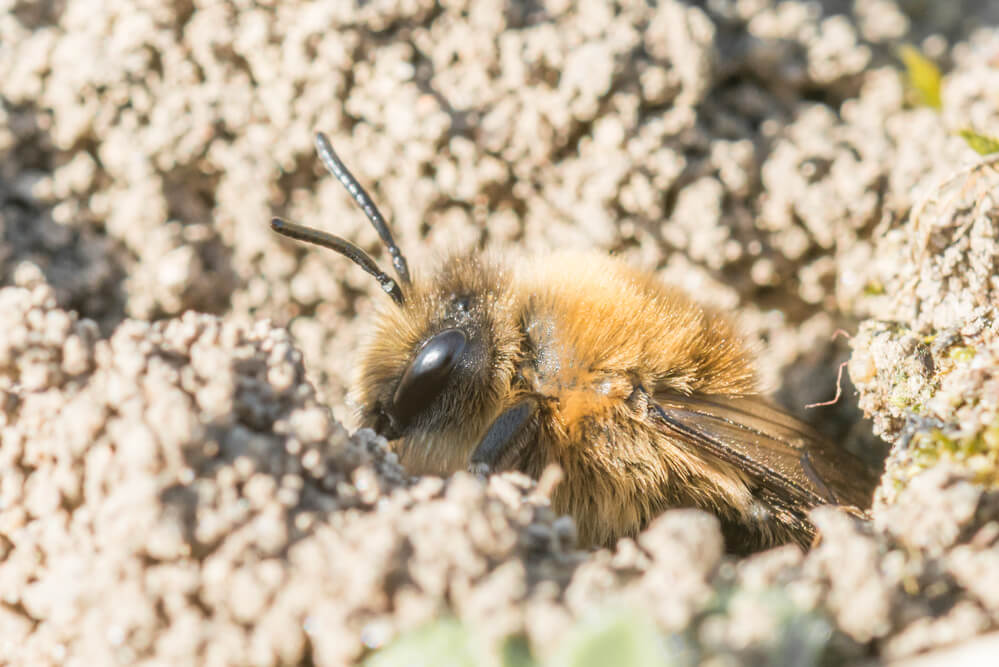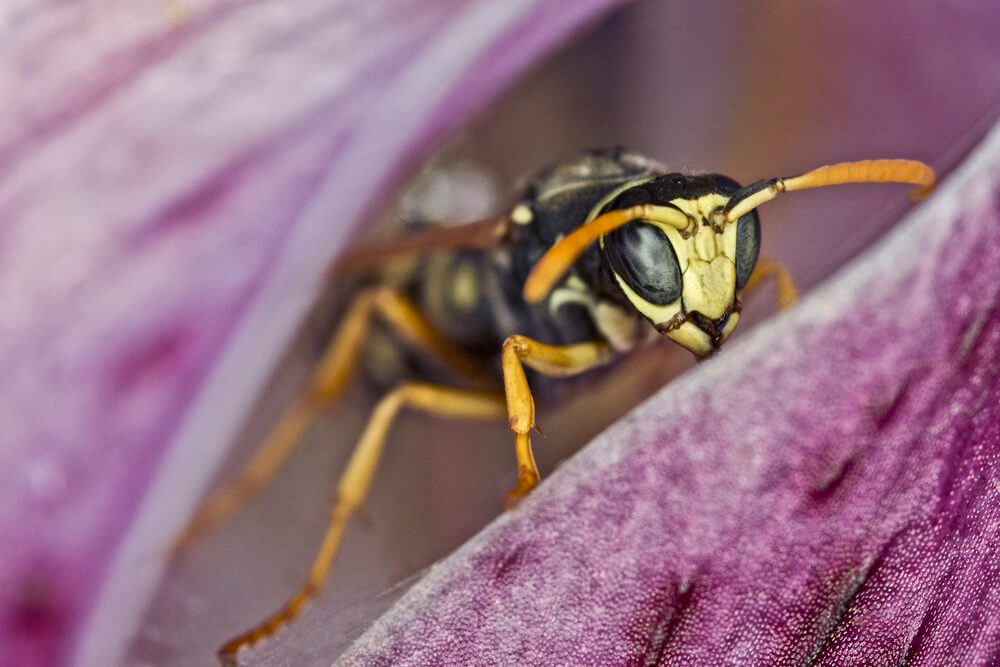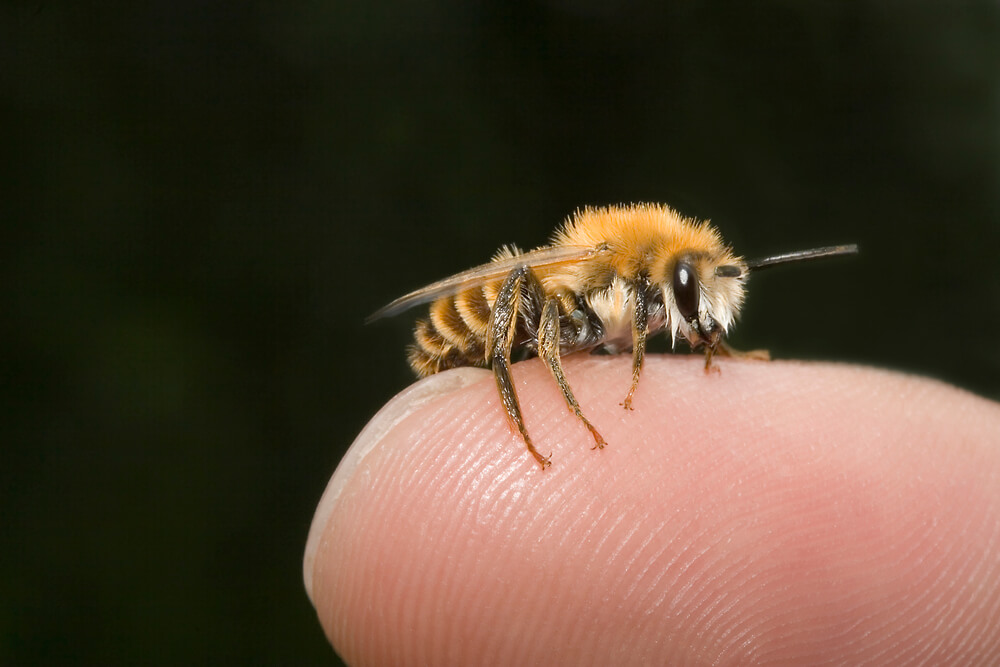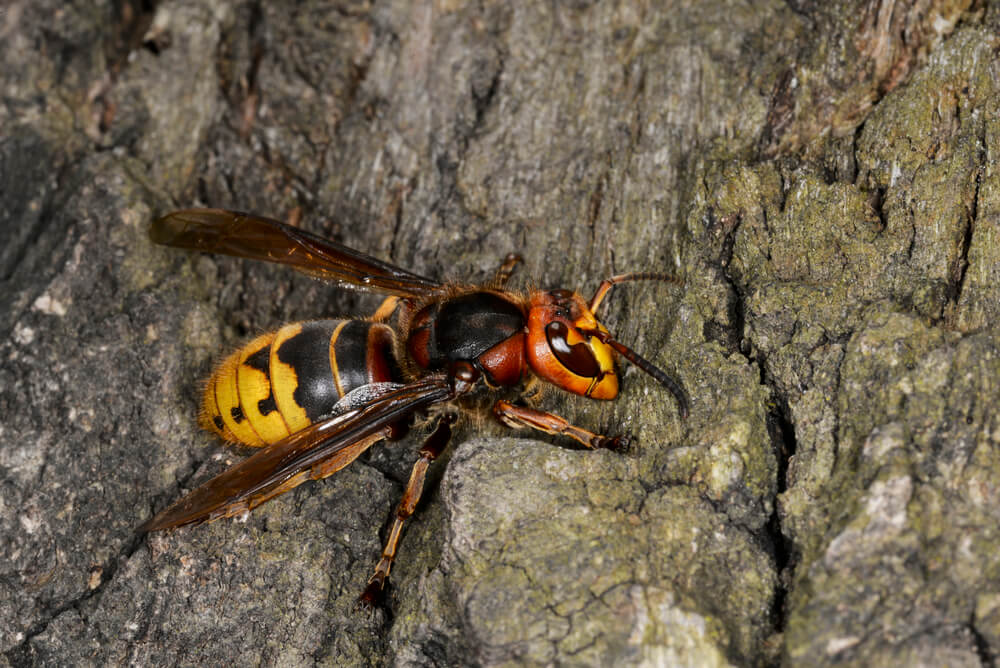Table of Contents:
Do Bees Hibernate?
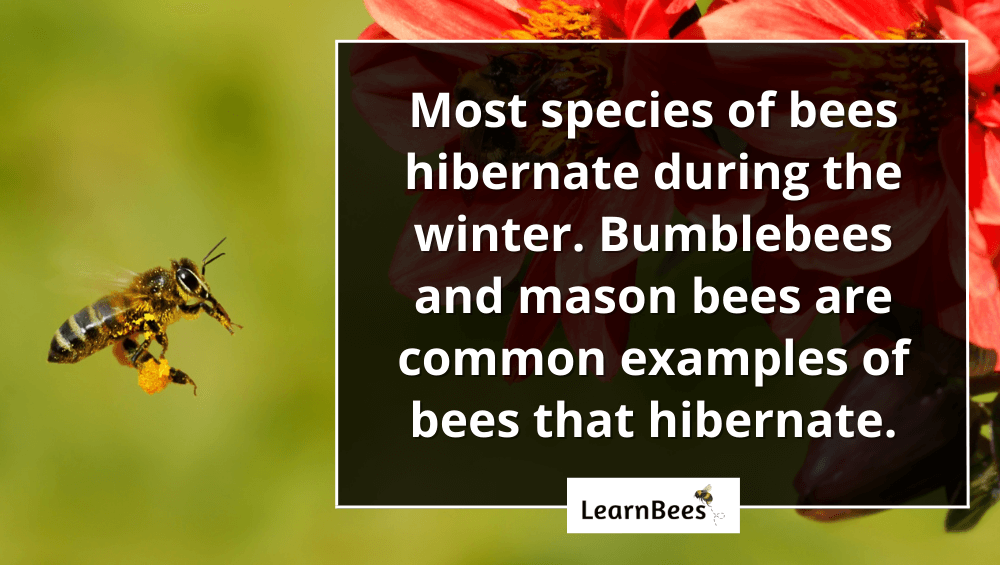
Yes, many species of bees hibernate during the winter.
Queen bumblebees, for example, go into hibernation when temperatures drop below 50°F (10°C).
The queen bumblebee typically finds a safe hibernation spot in the ground. Her metabolism slows down, and she burns little fuel while hibernating.
The rest of her colony dies before winter. Once spring arrives, the queen bumblebee lays eggs and builds a new colony.
Examples of other bee species that hibernate are:
- Mason bees
- Carpenter bees
- Leafcutter bees
- Carder bees
But what about honeybees?
Honeybees are different.
They don’t hibernate like bumblebees, mason bees, and carpenter bees do.
Instead, the entire honeybee colony huddles together in a large cluster around the queen bee. They generate heat by quickly vibrating their wings. For food, they rely on the honey they make during the warm months.
But this process isn’t foolproof.
Despite their best efforts, not all honeybee colonies survive the winter. In fact, winter is when the greatest number of honeybee losses occur. It’s a process of natural selection, where only the strongest and most adapted bees survive.
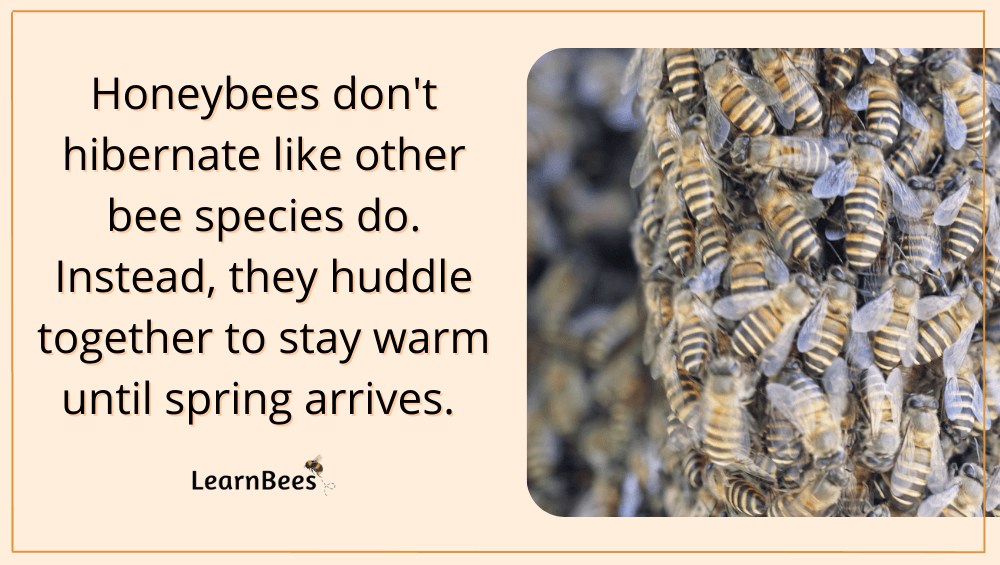
For example:
Honeybee colonies work relentlessly throughout the spring, summer, and early fall. They spend 10+ hours daily gathering nectar so they can make raw honey.
Why do they do it?
Because they need to produce enough honey to survive the winter.
You see, a bee’s diet consists of nectar and pollen from flowers. Nectar is a bee’s main carbohydrate source, while pollen is its main protein source. But flowers become scarce when the weather turns cold.
So this is where honey comes in.
Raw honey is their food storage for the winter months. But that’s not all. Honeybee colonies must also have a healthy population. This includes having enough bees to keep the hive warm, while also being free of diseases, parasites, and infections.
Why Do Bees Hibernate?
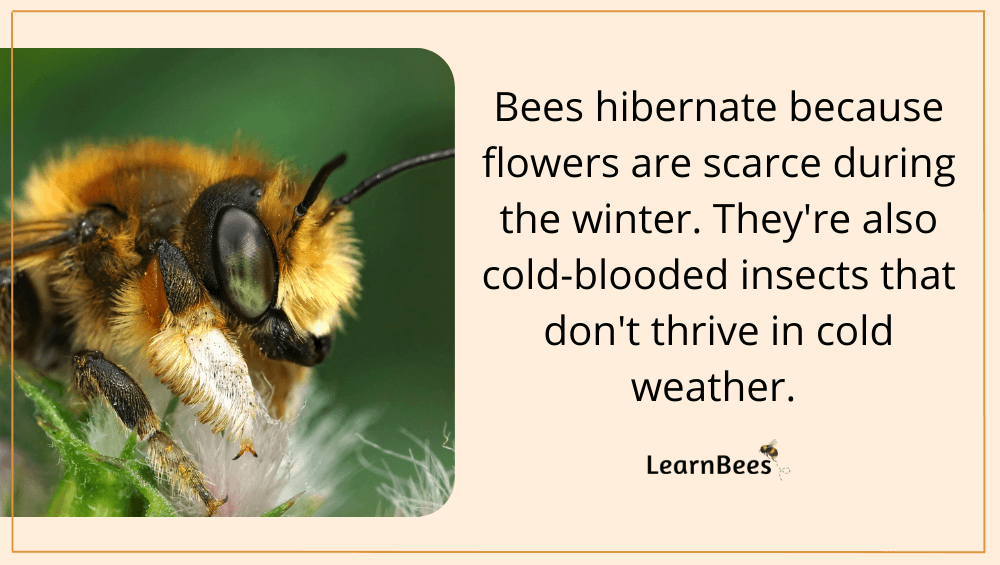
Bees hibernate for several reasons.
For one, bees are cold-blooded creatures. This means they can’t regulate their body temperature like warm-blooded creatures can. As a result, bees rely on heat from the sun or other sources, such as being active.
Secondly, bees need pollen and nectar from flowers to survive. But most flowers don’t bloom in the winter, so the bees have no choice but to hibernate until spring.
But remember:
Not all bees hibernate.
Honeybees are the most common example of bees that don’t hibernate. Honeybees simply huddle together to stay warm enough to survive the cold. They become active again outside of their hive once temperatures rise in the spring.
With that said, honeybees are the exception instead of the rule. Meaning, most species of bees hibernate during the winter.
How come, you ask?
Two reasons.
Firstly, most species of bees don’t produce honey like honeybees do.
As such, this means they don’t have anything to eat during the winter, so they must hibernate to survive. During hibernation, their body burns very little fuel, and they’re neither eating nor working.
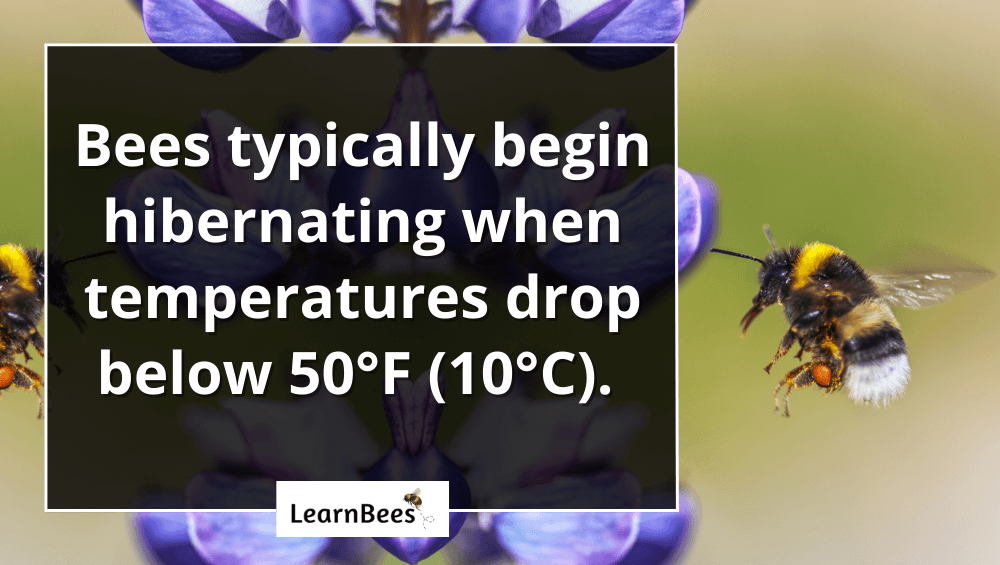
Secondly, most bee species are solitary bees that live alone.
For example, mason bees are solitary bees. This means that female mason bees are responsible for building their own nests and collecting their own food. As such, they don’t rely on other colony members to help keep them warm during the winter.
So hibernation it is.
And once warm weather arrives, hibernating bees will emerge to begin eating and nesting.
Now you might be wondering:
When do bees hibernate?
Bees typically begin hibernating when temperatures drop below 50°F (10°C). In the northern United States, these cooler temperatures can occur in October. In the southern United States, these cooler temperatures can occur as late as December or even January.
Where Do Bees Go in the Winter?

Now the big question becomes:
Where do bees go to hibernate?
Hibernation locations vary. That said, most bees hibernate in empty holes, away from the exposed elements and potential predators.
For example, queen bumblebees typically hibernate underground in empty rodent holes. In contrast, female carpenter bees hibernate in wooden tunnels.
But here’s the thing:
Most bee species live underground. In fact, a whopping 70% of bees build their nests underground.(1)
So it makes sense, then, that most bees also hibernate underground.
Hibernating underground helps keep them safe from predators while also providing insulation during the harsh winter months. In climates where the temperature rarely, if ever, drops below 50°F, many bees will remain active year-round.
FAQs on “Do Bees Hibernate?”
- At what temperature do bees become inactive?
- Do bees hibernate in the ground?
- Do bumble bees hibernate?
- How cold can honey bees survive?
- Do bees survive the winter?
- Where do honey bees go in the winter?
- Where do carpenter bees go in the winter?
- Where do queen bees go in the winter?
- At what temperature do bees die?
- What happens to bees in the winter?
At what temperature do bees become inactive?
“When do bees hibernate?” is a frequent question we get.
When temperatures drop below 50°F (10°C), bees will usually begin hibernating.
These cool temperatures can begin around October in the northern United States. In the southern United States, these cool temperatures may come as late as December or even January.
You’ll notice that the bees have started hibernating when you don’t hear or see them buzzing around. This is when flowers begin to die off, and food becomes scarce.
In colder climates, a bee’s hibernation can last from October until May. For example, it’s not uncommon for states like Vermont to have 45°F (7.2°C) temperatures in early May.
In contrast, Florida temperatures can be 70°F (21.1°C) or higher in May. Many warm weathered states never actually have a “true” winter.
—> Go back to the FAQs on “Do Bees Hibernate?”
More to Explore:
- Do Carpenter Bees Pollinate?
- How Long Do Bumble Bees Live?
- Honeybees vs. Bumblebees: How Do They Compare?
Do bees hibernate in the ground?
People often ask, “Do bees go in the ground in the winter?”
Yes, many bee species hibernate in the ground.
In fact, most bees build their nests underground. More specifically, a whopping 70% of bees create nests in the ground.
So naturally, this means that most bees also hibernate underground. This protects them from predators and natural elements such as wind, rain, and snow.
That said, when most people think of bees, they think of honeybee hives. Honeybee hives can be found hanging from tree branches or inside tree cavities. However, honeybees don’t hibernate.
Instead, honeybees become less active during the winter. They will cluster together to stay warm and provide insulation for their queen bee. They vibrate their wing muscles to generate heat.
During the winter, honeybees consume stored honey to give them energy. If there isn’t enough honey, the bees will starve to death.
—> Go back to the FAQs on “Do Bees Hibernate?”
More to Explore:
Do bumble bees hibernate? Where do bumble bees go in the winter?
Yes, bumblebees hibernate in the winter. More specifically, the queen bumblebee hibernates while the rest of the colony dies off. The rest of the bumblebee colony includes female worker bumblebees and male drone bees.
The queen bumblebee mates with a drone bumblebee in the fall. Once she has enough sperm stored, she will seek a place to hibernate for the winter. Usually, this involves finding a safe location in an empty rodent burrow, hollow tree, or crack in a building.
While the queen bumblebee hibernates, she won’t eat anything until she emerges in the spring. Instead, she will live off the fat stores she has built up in her body.
Once the weather starts to warm up in the spring, the queen bumblebee will come out of hibernation and begin to build her nest. She will then lay her eggs and build the bumblebee colony.
—> Go back to the FAQs on “Do Bees Hibernate?”
More to Explore:
- Ground Bees: Are They a Threat to Your Yard?
- Wasps vs. Honeybees: Are They Different?
- Do Bumble Bees Bite?
How cold can honey bees survive?
Like all bees, honeybees are cold-blooded creatures. They cannot withstand harsh winters. Honeybees become less active as temperatures drop below 50°F (10°C).
To survive the winter, honeybees cluster together in a tight ball. The bees in the center of the ball are kept warm by the bees on the outside. The honeybees will rotate so that no bee gets too cold.
With that in mind, the queen honeybee is kept in the center of the honeybee cluster. This is because she is the most important bee in the hive. She’s responsible for laying eggs that ensure the colony’s future generation.
As a result, the worker honeybees will feed her and keep her warm.
Additionally, the worker bees also eat honey during the winter. This provides them with the energy they need to keep the hive warm.
If there isn’t enough honey, the bees will starve. This is why beekeepers need to ensure that their hives have enough honey going into the winter.
—> Go back to the FAQs on “Do Bees Hibernate?”
More to Explore:
Do bees survive the winter?
Yes, bees can survive the winter if they’re prepared and healthy.
For example, honeybees must have a big enough population of bees and enough honey storage to make it through the winter. Also, they should be healthy and disease-free.
And just as important:
A honeybee hive must be well-insulated and ventilated. This helps keep the hive at a consistent temperature and prevents moisture buildup.
Other bees, such as carpenter bees, leafcutter bees, and bumblebees, will find a safe place to hibernate. This might be in the ground, a tree cavity, or cracks in buildings.
Like all animals, bees are vulnerable to predators, diseases, and elements. However, if they’re healthy and prepared, bees can make it through the winter.
—> Go back to the FAQs on “Do Bees Hibernate?”
More to Explore:
Where do honey bees go in the winter?
Honeybees will stay in their hive during the winter.
The worker bees will form a tight cluster around the queen bee. The bees in the cluster’s center will stay warm by bees on the outside. The honeybees will rotate from the outside to the inside so that all bees have the chance to get warm.
Established, strong honeybee hives have a better chance of surviving the winter than new hives do. This is because the established hives have a larger population of bees and more stored honey.
—> Go back to the FAQs on “Do Bees Hibernate?”
More to Explore:
Where do carpenter bees go in the winter?
Carpenter bees drill into wood to build nests. As such, they also tend to hibernate inside wooden tunnels in cedar or cypress trees.
Carpenter bees are also notorious for drilling holes inside houses, fences, and sheds. This means they may also potentially nest in the burrows around your home. To deter carpenter bees naturally, read our guide on How to Get Rid of Carpenter Bees Without Harming Them.
—> Go back to the FAQs on “Do Bees Hibernate?”
More to Explore:
Where do queen bees go in the winter?
Queen honeybees remain inside their beehive during the winter. The worker bees form a warm cluster around her to prevent her from getting too cold.
Other bees, such as queen bumblebees, will find a safe hibernation location underground inside empty mouse burrows.
—> Go back to the FAQs on “Do Bees Hibernate?”
More to Explore:
At what temperature do bees die?
Honeybees maintain their nest at a temperature of 90°-95°F throughout the winter, even when the outside temperature is in the single digits. They cluster together and shiver their wing muscles to create heat.
When an individual bee’s temperature dips below 45°F, it can lead to death. This is why honeybees huddle together to stay warm.
Similarly, other bees will hibernate in holes that help provide insulation from the harsh weather.
—> Go back to the FAQs on “Do Bees Hibernate?”
More to Explore:
What happens to bees in the winter?
This is a common question we get, along with dozens of other questions such as:
Do bees die or do they hibernate? Do all bees die in the winter? Do bees go dormant in winter? Where do bees and wasps go in the winter? Do bees hibernate or migrate? Where do bees hibernate in the winter? Where do bees go for winter? Where do bees go in the wintertime? Where do bees go during winter?
The answer is that some bees hibernate (such as queen bumblebees), while others simply become less active (such as honeybees).
Bees that hibernate will find a safe place to sleep through the winter months. This might be in the ground, a tree cavity, or cracks in buildings.
Bees that don’t hibernate (such as honeybees) will stay in their hive during the winter. The worker bees will congregate around the queen bee, forming a tight huddle to stay warm.
